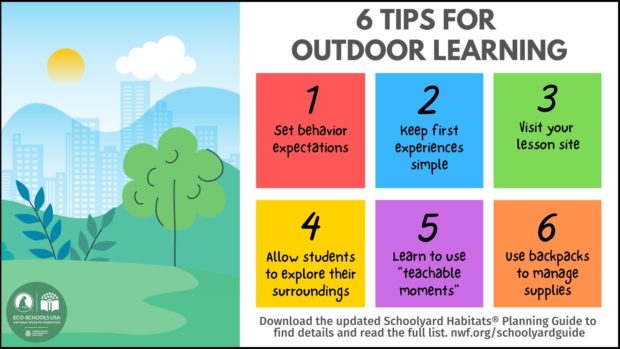We have much more to do and your continued support is needed now more than ever.
5 Ways to Take the National Wildlife Federation’s Education Programs Back to School

As a new month begins, many educators and students have already been in school for several weeks, with some returning to the physical classroom for the first time in over a year. We recognize that there will be added stress for many when stepping back into the classroom after the unprecedented events of the past year and ongoing concerns around in-person learning. The education team at the National Wildlife Federation is here to support your work as you plan for the new school year. We encourage you to focus on the intersections between equity, the environment, and economics (Education for Sustainable Development) as you:
- foster youth leadership to create sustainable change through the Eco-Schools USA pathways;
- design and create climate-resilient solutions for your schoolyard and community; and
- lead students in environmental justice work.
Here are five ways to incorporate NWF’s education programs into a new school year filled with excitement and opportunity.
1. Get Inspired with Stories from the Field.
Students and teachers have implemented sustainable solutions at school for over ten years, guided by the Seven Step Framework of the Eco-Schools USA program. New for the 2021 school year, we are launching a story feature on our website to share uplifting stories from the field. The stories are meant to recognize the different ways students and teachers are making positive changes and inspiring others at schools across the country. From our friends at Piney Point Elementary in Houston, Texas, the first story focuses on resilience. Educators, students, and districts interested in sharing their stories in a future collaboration can email eco-schoolsusa@nwf.org to learn more.
2. Take Students Outside With a Collection of Flexible Learning Resources.
Need a lesson about biodiversity? Looking for a short, outdoor bird-watching activity? How about Nature Play at Home Guides from our Early Childhood Health Outdoors (ECHO) program? Bookmark this page to find age-appropriate flexible learning activities and resources together in one place. And don’t forget about free classroom resources such as the Ranger Rick ® Educator’s Guide and Nature Notebook activities. Before you head outside, consider these helpful tips for outdoor learning from our Schoolyard Habitats® team.

3. Join Us in Celebrating the 20th Anniversary of the Earth Tomorrow program.
Since 2001, more than 5,000 primarily Black youth and youth of color have been involved in the Earth Tomorrow program. Youth have opportunities for leadership development training, civic engagement to address environmental justice issues, and a chance for outdoor exploration in the Atlanta area. Watch the Earth Tomorrow: 20th Anniversary video to see how the program has prepared the next generation of environmental leaders to take action for their local community and beyond.
4. Create a Schoolyard Habitat®.
What does your schoolyard look like? Is there a safe space for outdoor learning and nature-based investigations? Are there native plants to attract pollinators? The beginning of the school year is the perfect time to begin designing, building, and certifying a Schoolyard Habitat through the National Wildlife Federation. Explore the updated planning guide to learn more.
If your school or learning center is one of almost 10,000 Certified Schoolyard Habitats, consider inviting older youth and community members to try their hand at photography for the Garden for Wildlife™ Photo Contest. Submissions will be accepted between now and October 17, 2021, in five categories, including the Young Habitat Photographers for ages 13-17. Learn more about the contest requirements, plus helpful tips for wildlife photography.
5. Make a Plan for Student Action.
Each month, Eco-Schools USA highlights action days that offer student engagement paths around topics connected to the Global Goals. For September, explore NOAA’s National Estuarine Research Reserve System’s educational activities and resources as part of National Estuaries Week (SDG 14). Or get involved with NEEF’s National Public Lands Day (SDG 3 & 15) on September 25. Bookmark this page on our website for monthly updates.

Be sure to sign up to receive all the latest K-12 education news directly to your inbox. As we move into fall, email will be our primary method of communicating K-12 news, the latest resources, and events. Stay tuned as we launch a redesigned education newsletter later this year, uplifting communities and sharing stories across our suite of education programs, including early childhood, K-12, higher education, and communities.
Professional Development





















